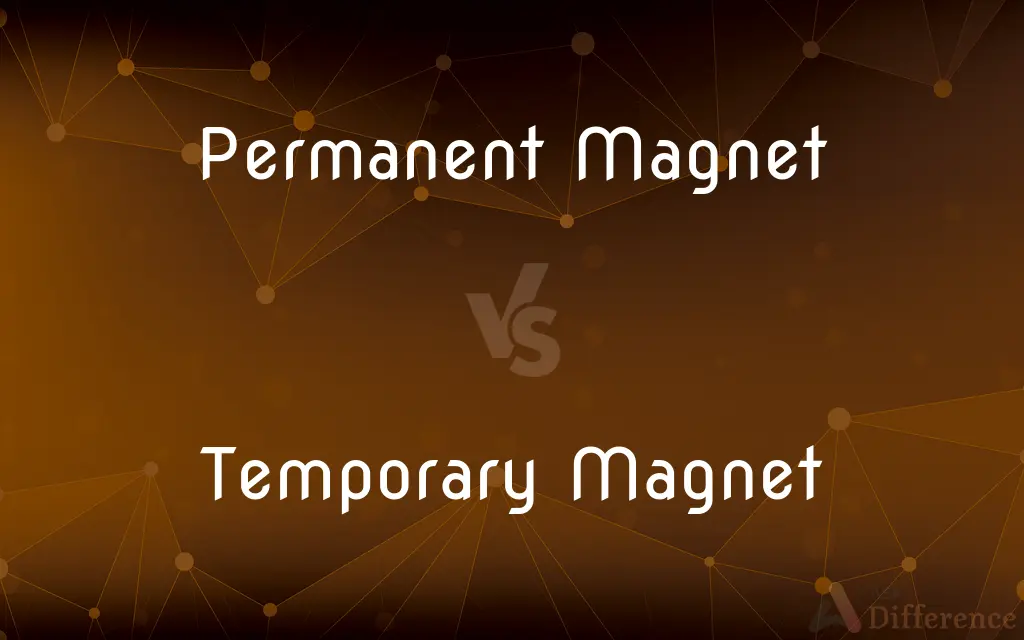Permanent Magnet vs. Temporary Magnet — What's the Difference?
By Tayyaba Rehman — Published on November 16, 2023
Permanent magnets retain magnetism long-term, while temporary magnets lose their magnetism when the inducing field is removed.

Difference Between Permanent Magnet and Temporary Magnet
Table of Contents
ADVERTISEMENT
Key Differences
Permanent magnets and temporary magnets embody distinctive magnetic attributes, navigating through different realms of functionality and application. A permanent magnet perpetually maintains its magnetic field, loyally preserving its magnetic properties under ordinary conditions. In contrast, a temporary magnet basks in its magnetic capabilities only in the presence of an external magnetic field, surrendering its magnetic persona upon its departure.
Elaborating further, the permanent magnet stands unwaveringly magnetic, producing its magnetic field autonomously without the assistance of an external magnetic influence. Yet, the temporary magnet hinges on an external magnetic field for its identity, embracing magnetism only when in its company, and losing the magnetic temperament when the external field withdraws. This transient magnetic nature shapes the temporary magnet's limited and context-dependent utility.
When exploring practical applications, permanent magnets assert their utility in devices requiring consistent and enduring magnetism, such as in motors and generators. On the flip side, temporary magnets render their service in contexts demanding conditional magnetism, like in electromagnets, where their magnetic phase is activated and deactivated per necessity, underlining a diametric utilization of permanent and temporary magnetism in technological realms.
Delving into the materialistic viewpoint, permanent magnets are typically crafted from materials, such as ferromagnetic materials, that intrinsically support sustained magnetic ordering. Conversely, temporary magnets, often made from materials like soft iron, endorse a fleeting magnetic order that easily succumbs to disorder when the instigating magnetic field retreats, highlighting a fundamental material distinction between permanent and temporary magnetic existence.
In the scientific and technological arenas, permanent magnets perpetually serve as steadfast sources of magnetic fields in myriad applications, from data storage devices to healthcare equipment. Temporary magnets, however, carve their niche in applications demanding controllable magnetism, such as in transformers and certain types of relays, showcasing an application-based dichotomy sprouted from the inherent natures of permanent and temporary magnets.
ADVERTISEMENT
Comparison Chart
Duration of Magnetism
Long-term/Permanent
Short-term/Temporary
Dependency on External Field
Not dependent
Dependent
Material Characteristics
Hard magnetic materials
Soft magnetic materials
Example Applications
Motors, Generators
Electromagnets, Core of transformers
Magnetic Strength
Generally stronger
Generally weaker
Compare with Definitions
Permanent Magnet
Enduring Magnetic Entity
A permanent magnet, like the one in a compass, maintains its magnetism over time.
Temporary Magnet
Short-lived Magnetic Substance
A temporary magnet, like a nail, will magnetize near a strong magnet and demagnetize away from it.
Permanent Magnet
Intrinsic Magnetic Retainer
Permanent magnets in hard drives store data by maintaining their magnetism.
Temporary Magnet
Externally Influenced Magnetic Entity
In a relay, a temporary magnet activates a switch under an external magnetic influence.
Permanent Magnet
Inherent Magnetic Object
The permanent magnet in a refrigerator door supports closure by sticking to the metallic frame.
Temporary Magnet
Transient Magnetic Participant
The temporary magnet in an electromagnet crane loses its magnetism, releasing the lifted material.
Permanent Magnet
Self-Sufficient Magnetic Source
The permanent magnet in the speaker provides a steady magnetic field.
Temporary Magnet
Temporarily Induced Magnetic Material
In a transformer, a temporary magnet in the core magnetizes and demagnetizes rapidly with the alternating current.
Permanent Magnet
Persistent Magnetic Actor
Permanent magnets in electric motors facilitate motion through sustained magnetism.
Temporary Magnet
Conditional Magnetic Object
A temporary magnet lifts metal objects when magnetized by an external field.
Common Curiosities
Can permanent magnets be demagnetized?
Yes, through heating, hammering, or placing in an opposing magnetic field, permanent magnets can be demagnetized.
Do permanent magnets ever lose their magnetism?
Yes, permanent magnets can lose magnetism under extreme heat or other disruptive conditions.
What materials are permanent magnets usually made of?
Permanent magnets are typically made from ferromagnetic materials like iron, cobalt, or nickel.
How are permanent magnets used in motors?
Permanent magnets in motors generate a magnetic field that interacts with electric currents to produce motion.
When does a temporary magnet exhibit magnetic properties?
A temporary magnet shows magnetic properties only in the presence of an external magnetic field.
What is a typical application of a temporary magnet?
Temporary magnets are commonly used in electromagnets, such as those in scrapyards to lift cars.
How does a temporary magnet gain magnetism?
Temporary magnets become magnetic under the influence of an external magnetic field.
How do permanent magnets impact everyday technologies?
Permanent magnets are pivotal in devices like computers, speakers, and electric cars.
Are temporary magnets weaker than permanent magnets?
Generally, yes, temporary magnets tend to have weaker magnetic fields compared to permanent magnets.
Can permanent magnets be manufactured?
Yes, permanent magnets can be manufactured using ferromagnetic materials and magnetization processes.
How do permanent magnets assist in data storage?
Permanent magnets in hard drives store data by aligning bits magnetically in a particular direction.
Can temporary magnets become permanent magnets?
No, temporary magnets cannot maintain magnetism without an external field, unlike permanent magnets.
Can temporary magnets create their magnetic field?
No, temporary magnets do not create their magnetic field but require an external field for magnetism.
Are temporary magnets used in electric circuits?
Yes, temporary magnets, especially electromagnets, are used in circuits, relays, and transformers.
Can temporary magnets be useful in scientific experiments?
Yes, temporary magnets, particularly electromagnets, can be used in experiments requiring controlled magnetic fields.
Share Your Discovery

Previous Comparison
Diet Coke vs. Coke Zero
Next Comparison
Hall Effect vs. Quantum Hall EffectAuthor Spotlight
Written by
Tayyaba RehmanTayyaba Rehman is a distinguished writer, currently serving as a primary contributor to askdifference.com. As a researcher in semantics and etymology, Tayyaba's passion for the complexity of languages and their distinctions has found a perfect home on the platform. Tayyaba delves into the intricacies of language, distinguishing between commonly confused words and phrases, thereby providing clarity for readers worldwide.













































